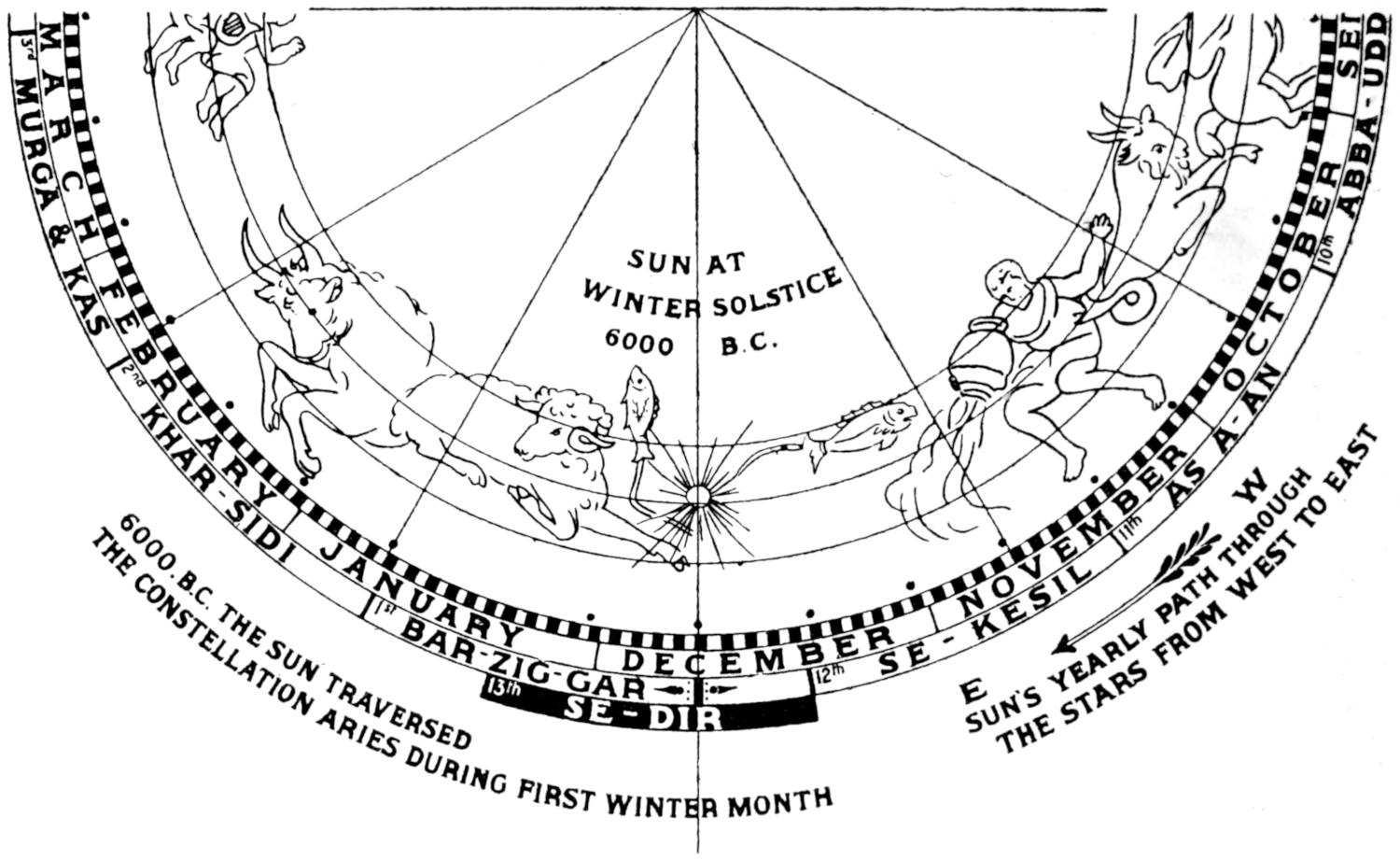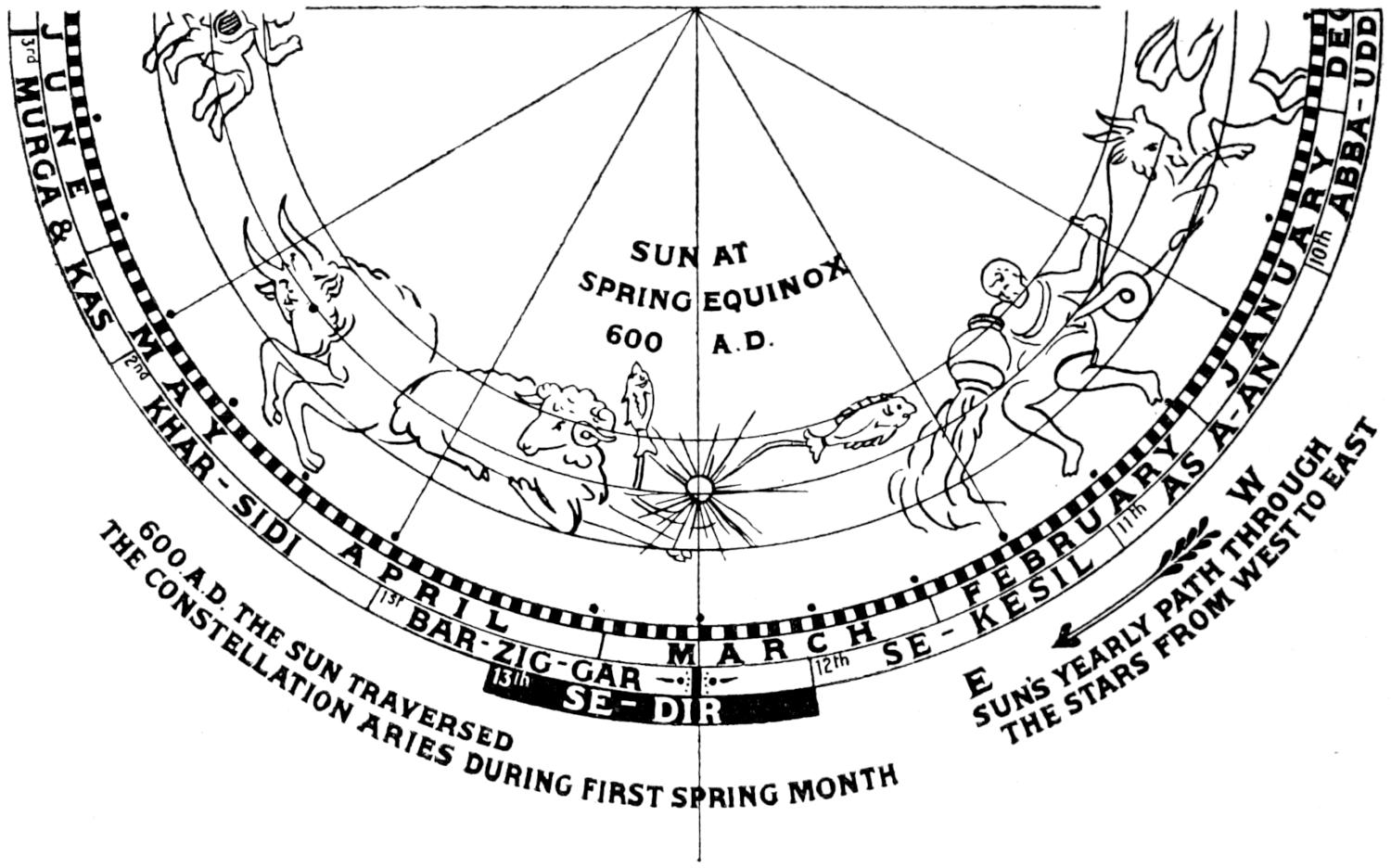The Akkadian Calendar from Ancient Babylon
“The Akkadian calendar was organized to follow the order of the zodiacal signs, with the first month, Nisan, corresponding to the first sign. The second month of the Accadian year, Taurus, introduced spring, and would have done so from 4698 B.C. to 2540 B.C.
I
THE ACCADIAN CALENDAR [Akkadian]
[Reprinted from the Proceedings of the Society of Biblical Archæology, January 1892]
“Epping and Strassmaier, in their book Astronomisches aus Babylon, have lately translated three small documents, originally inscribed on clay tablets in the second century B.C. From these tablets, we learn that the Babylonians of the above date possessed a very advanced knowledge of the science of astronomy. Into the question of the extent of that knowledge we need not here enter further[2] than to say that it enabled the Babylonian astronomers to draw up almanacs for the ensuing year; almanacs in which the eclipses of the sun and moon, and the times of the new and full moon, were accurately noted, as also the positions of the planets throughout the year. These positions were indicated by the nearness of the planet in question to some star in the vicinity of the ecliptic, and the ecliptic was portioned off into twelve groups, coinciding very closely in position and extent with the twelve divisions of the Zodiac as we now know them. …
“Out of every eleven years there were seven with twelve months, and four with thirteen months. The first day of the year being, like some of our church festivals, dependent on the time of the new moon, was “moveable” (schwankende). The year, according to the tablets before Epping and Strassmaier, “began with Nisan, hence in the spring.”[1] …
“But, further, there are astrological works copied for the library of Assurbanipal from ancient Babylonian originals. The compilation of many of these originals is placed by scholars in the reign of Sargon of Accad,[5] at the remote date of 3,800 B.C. …
“Let us suppose that the calendar which, as we may learn from the astrological tablets, was already in Sargon’s time a well known and venerated institution, had been originally drawn up at a date much earlier than Sargon’s, when the first month (Bar zig-gar), was not the first spring month, but when it was the first winter month of the year.

This date would have been about 6,000 B.C.; for then the sun entered the constellation Aries at the winter solstice—a season equally well, if not better suited than the spring equinox to hold the first place in the calendar.[8] Under this[14] supposition, it would no longer be difficult to imagine why the ancient Accadian astronomers should have chosen Aries as the first constellation of the Zodiac, and Nisan (Bar zig-gar) as the first month, and the “beginning of the year.”


. . .
ASTRONOMY IN THE RIG VEDA [India]
[Reprinted from the Report of the Actes of the Twelfth Oriental Congress held at Rome]
“I engage to support an opinion (which the learned and industrious M. Montucla seems to treat with extreme contempt) that the Indian division of the Zodiack was not borrowed from the Greeks or Arabs, but, having been known in this country (India) for time immemorial, and being the same in part with that used by other nations of the old Hindu race, was probably invented by the first progenitors of that race before their dispersion.”[43]
[43]On the Antiquity of the Indian Zodiack. Complete Works, vol. i. p. 333.
Indian Zodiac “Outer circle divided into 360 degrees
“2nd circle. The names and extent of the twenty-seven Indian “Nakshatras” or divisions of the Lunar Zodiac.
“3rd circle. Names and extent of the twelve Indian “Rashis” or divisions of the Solar Zodiac.
“4th circle. Proposed three-fold division of the Vedic Lunar Month at Season of Summer Solstice.
“Section of 5th circle. Proposed identification of “Maruts” with Moon’s course through seven “Nakshatras” at Season of Summer Solstice.
“The Constellations here appear as drawn on the celestial globe; they have not been reversed as in the other illustrations, hence an apparent, though not real, contradiction ensues.” Plunket, Emmeline. Ancient Calendars and Constellations
Discover more from Jacki Kellum
Subscribe to get the latest posts sent to your email.